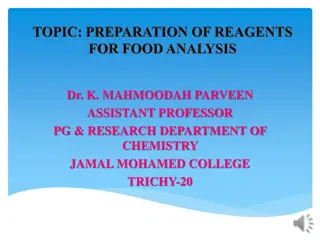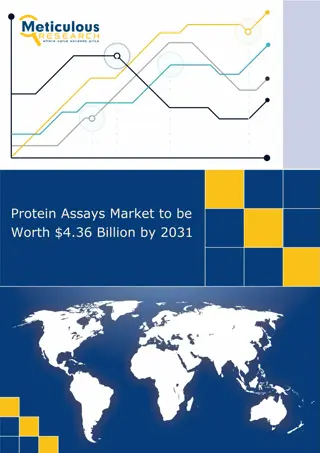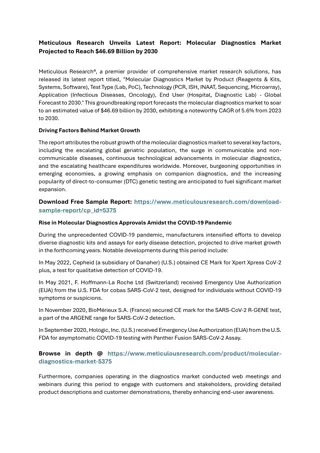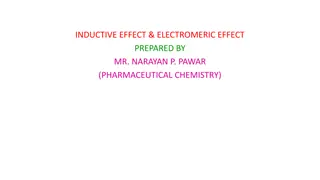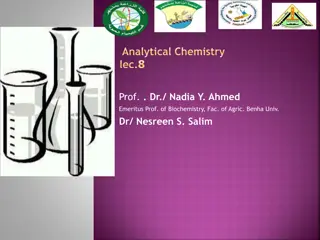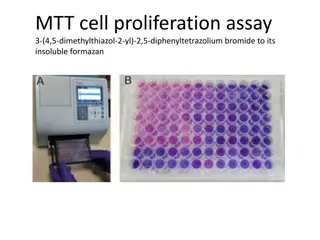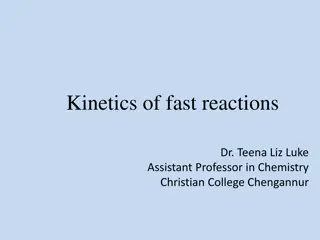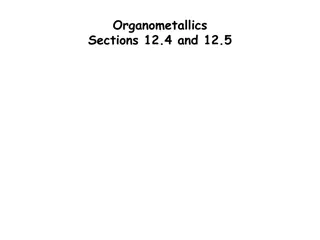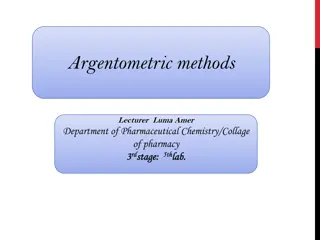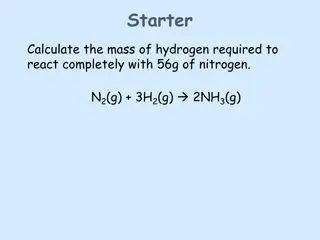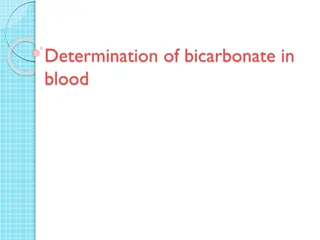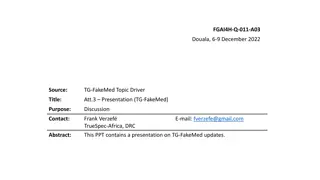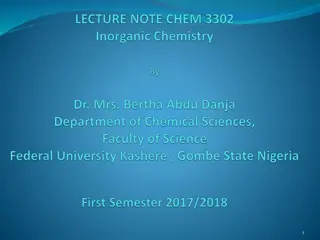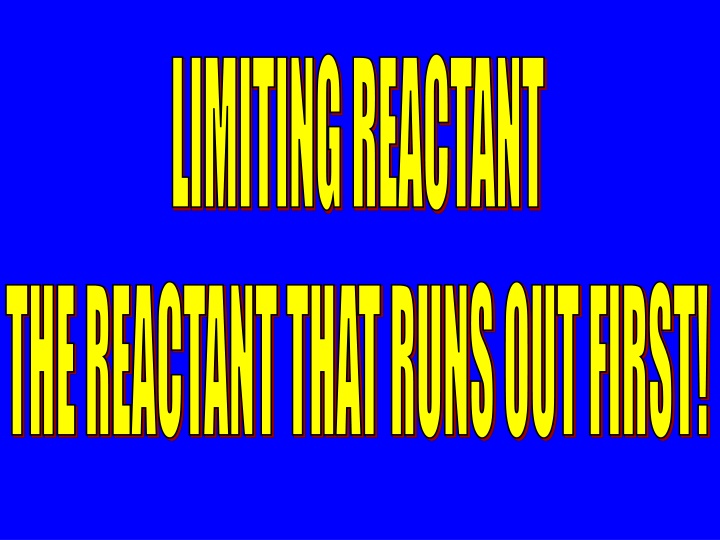
Limiting Reactant Concepts in Chemistry
Learn about limiting reactants in chemistry, where specific amounts of both reactants are given, affecting the reaction outcome. Explore scenarios and calculations to determine the limiting reactant and understand its significance. Discover practical examples such as nuts and bolts combinations to grasp the concept effectively.
Download Presentation

Please find below an Image/Link to download the presentation.
The content on the website is provided AS IS for your information and personal use only. It may not be sold, licensed, or shared on other websites without obtaining consent from the author. If you encounter any issues during the download, it is possible that the publisher has removed the file from their server.
You are allowed to download the files provided on this website for personal or commercial use, subject to the condition that they are used lawfully. All files are the property of their respective owners.
The content on the website is provided AS IS for your information and personal use only. It may not be sold, licensed, or shared on other websites without obtaining consent from the author.
E N D
Presentation Transcript
Limiting Reactant Calculations In the reactions previously discussed, an amount of only one of the reactants was given. We assumed that we could use as much of the other reactant as we needed. Unfortunately, this is not always the case. Situations where specific amounts of both of the reactants are given are called limiting reactant problems. The limiting reactant is the one that runs out first! In limiting reactant problems three possibilities exist. Possibility one is that the first reactant is used up first. Possibility two is that the second reactant runs out first and possibility three is that both reactants run out at the same time.
Understanding Limit Reactant Concepts Containers of nuts and bolts are to be threaded together. One nut threaded on one bolt. How many combinations Can be made ? + Only four nut bolt combinations can be made. The bolts have run out. The bolts are the limiting factor nuts bolts
Understanding Limit Reactant Concepts Containers of nuts and bolts are to be threaded together. Two nuts threaded on one bolt. How many combinations Can be made ? + Only three nut bolt combinations can be made. The nuts have run out. The nuts are the limiting factor bolts nuts The one with the smallest number is not always the limiting factor. It depends on the ratio of combinations!
THOUGHT LAB: 1 car body + 4 wheels + 2 wipers 1 car 1 car body : 4 wheels : 2 wipers : 1 car 1) If you have 35 car bodies, 120 wheels, 150 wipers how many complete cars can you make? Ans: You can only make a max of 30 cars because every car requires 4 wheels!!!
THOUGHT LAB: 2) a) Which item is limiting? Ans: The wheels are limiting or in other words, the wheels will run out first! 2) b) Which items are in excess? Ans: The body and wipers
THOUGHT LAB: 2) c) How much of the excess item remains after the reaction? If you use up all the wheels (120), you have made 30 cars. Each car requires 1 body and 2 blades so you will also use up 30 bodies and 60 blades. This means you have 5 car bodies and 90 blades remaining!!!
THOUGHT LAB: ANALYSIS 1) Does the excess amount of an item affect the quantity of product made? Ans: No, because they are just extra (left- over) items
THOUGHT LAB: ANALYSIS 2) Even though there are fewer car bodies than wheels and wipers, explain why car bodies are NOT the limiting item (though they are the smallest in amount) Ans: This is because the least amount of them are needed for the reaction to occur Every 1 car : 4 wheels (you cannot have a car with less than 4 wheels!) OR
LIMITNG REACTANT The reactant which is completely used up It determines how much product will be produced Ex: wheels
EXCESS REACTANT A reactant that is left over in a reaction Once the limiting reactant is used up, no more excess reactants can be used Ex: car bodies, wipers
When solving problems with LR THINGS TO THINK ABOUT How do we know how much product is produced? Which reactant is limiting? It s the reactant that will product the least amount of product Set up mole ratio product with the LIMITING REACTANT
LIMITING REACTANT EXAMPLE Li3N(s) + H2O(l) NH3(g) + LiOH(aq) a) If you have 4.87g Li3N and 5.80g water for the above reaction, what is the LR? b) How much NH3(g) is produced? c) How much LiOH is produced? First we have to balance our chemical reaction! Li3N(s) + 3 H2O(l) NH3(g) + 3 LiOH(aq)
LIMITING REACTANT EXAMPLE GIVEN: Li3N m of Li3N = 4.87 g Therefore, n= m/M = 0.140 mol Li3N M = 34.8 g/mol H2O m of H2O = 5.80 g Therefore, n=m/M = 0.322 mol H2O M = 18.02 g/mol
LIMITING REACTANT EXAMPLE 1) Find the LR: look at both reactants Li3N: 1 mol Li3N = 1 mol NH3 0.140 mol Li3N x mol NH3 x = 0.140 mol NH3 b) H2O: 3 mol H2O = 1 mol NH3 0.322 mol H2O x mol NH3 x = 0.107 mol NH3 Since the least amount of NH3 is produced from H2O, it is the LR
LIMITING REACTANT EXAMPLE b) How much NH3 is produced? Since H2O is the limiting reactant, we know that 0.107 mol NH3 is produced (part a) n of NH3 = 0.107 mol M of NH3 = 17.03 g/mol m = n x M = 0.107 mol x 17.03 g/mol = 1.82 g NH3
LIMITING REACTANT EXAMPLE c) How much LiOH is produced? Set up mole ratio with LR ONLY 3 mol H2O 0.322 mol H2O (given) x mol LiOH x = 0.322 mol LiOH = 3 mol LiOH M of LiOH = 23.95 g/mol m = n x M = 0.322 mol x 23.95 g/mol = 7.71 g Therefore, 7.71 g LiOH will be produced
Just wondering How much Li3N is left over? Set up mole ratio with LR (H2O) 1 Li3N = 3H2O x Li3N 0.322 mol H2O x = 0.107 mol Li3N was used Total mol of available Li3N was 0.140 mol; but only used 0.107 mol of the available. 0.140 mol 0.107 mol = 0.033 mol was left over m = n x M m = 0.033 mol Li3N x 34.8 g/mol = 1.15 g of Li3N will be left over.
Limiting Reactant Now, let s try a limiting factor (reactant) problem using a chemical reaction! Remember, numbers of atoms and molecules are measured in moles. The balanced equation tells us the ratio of combination of the atoms and molecules that are used to make the products. In the reaction: H2 + I2 2 HI, one molecule of hydrogen is combined with one molecule of iodine to give two molecules of hydrogen iodide. It is also true to say that one mole of hydrogen is combined with one mole of iodine to give two moles of hydrogen iodide. All we have really done is multiply the entire equation through by 6.02 x 1023 (1 mole).
Limiting Reactant H2 + I2 2 HI Suppose that exactly one mole of H2 and exactly one mole of I2 are available. In this case we can make exactly two moles of HI and no H2 or I2 will be left. Now, suppose that we have one mole of H2 and two moles of I2. Once the H2 is used up, no more I2 can be reacted. One mole of H2will use exactly one mole of I2 leaving an extra mole of I2 unused. The limiting reactant is H2. It ran out first. The excess reactant is I2. We have extra I2. Only two moles of HI can be made. According to our balanced equation, for each H2 used, two HI are formed. Only one mole of H2 was used so only two moles of HI are produced. The quantity of products formed is based on the limiting reactant!
Limiting Reactant Problem: Given the reaction: 1Ca + 1Cl2 1CaCl2. If we mix 120 grams of calcium and 71 grams of chlorine, which reactant is the limiting factor? How many grams of CaCl2 can be made? Solution: Remember that balanced equations are based on moles. We must first convert the given grams to moles. Moles for Ca = 120 / 40 = 3.0, Moles for Cl2 = 71 / (2 x 35.5) = 1.0 From the balanced equation, 1 Ca requires exactly 1 Cl2. Since only 1.0 mole of Cl2 is available only 1.0 mole of Ca can be consumed and 2.0 moles of Ca remain unused. Chlorine (Cl2) is the limiting reactant. The amount of product that can be formed is based on the limiting reactant. The equation tells that for each Cl2 used, one CaCl2 is made. Since 1.0 mole Cl2 are used, 1.0 mole of CaCl2 are produced. Grams CaCl2 = 1.0 moles x (40 +2(35.5)) grams per mole = 111 g
Limiting Reactant Problem: Given the equation: 2Na + Cl2 2NaCl. How many grams of NaCl can be made by reacting 69 grams of Na with 5.0 moles of Cl2 ? Solution: Again we must work in moles. Cl2 is already moles but Na must be converted (69 / 23 = 3.0 moles of Na) From the equation, 2Na needs 1Cl2 (half the moles of Na) so 3 Na needs 1.5 moles of Cl2. We have 5.0 moles of Cl2, more than enough. Therefore all of the Na is used and Na is the limiting reactant! The amount of product is based on the limiting reactant. Since 2Na make 2NaCl, 3.0 Na will make 3.0 NaCl Grams of NaCl = 3.0 moles x (23 + 35.5) gram per mole of NaCl = 175.5 grams of NaCl are formed.
HOMEWORK Practice Problems : page 309 #31-39 Practice Problems: page 311 #30-50
References Walt Sautter TEMPUS EST


